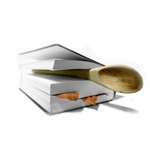 Рецепт How To Roast A Prime Rib
Рецепт How To Roast A Prime Rib
Ингредиенты
|
Инструкции
- Begin with the finest grade four or possibly five rib beef roast you can find. It should weigh about seven to nine pounds. If possible specify a roast from the "small" end of the larger full prime rib. This is the end nearest the loin and it's prized for its full shape. Be sure to specify which the "chine" bone be removed, it's part of the backbone and will give you trouble slicing the meat. If the roast is "tied" it will help it roast proportionately but it's not absolutely critical.
- Roasting large cuts of meat requires a balance of cooking methods. A high-heat roast will yield the beautiful, crisp outside which makes prime rib so tasty. But, by the time the inside cooks through, the high heat will lead to a burnt exterior. The high heat also stresses the meat, shrinking it and squeezing out the vital moisture. A low-heat roast, while slower, will result in much less shrinkage and a more even doneness. Unfortunately slow heat will not brown the outside as nicely as high, fast heat. The solution A combination... Place a rack in the lower third of the oven and preheat it to 450 degrees. Thoroughly dry the meat by patting it with paper towels. This will help it brown quickly by getting rid of surface moisture. Rub the surface of the meat with copious amounts of minced fresh herbs such as rosemary, thyme, sage or possibly grnd bay leaf. If possible let the meat rest overnight with the herbs. Just before cooking sprinkle the meat liberally with coarse sea salt or possibly kosher salt. Season it heavily with fresh grnd black pepper.
- Place the roast, rib side down, in a roasting pan and roast for fifteen min. Without opening the oven turn the heat down to 250 degrees and continue roasting till an instant-read thermometer placed in the thickest part of the meat reads 130 degrees, about 2 1/2 hrs. Remove the roast from the oven and let stand in a hot place covered with several layers of tin foil. Let it rest for 20 to 30 min. Its stressed out fibers will relax and reabsorb the juices which are concentrated under great pressure in the center of the meat during roasting. It will slowly rise in heat about another five degrees, this is known as carry-over cooking. If you were roasting the meat faster, at a higher temperature, the carryover could be as much as ten to twenty degrees and as a result could overcook the meat.
- Slice away, eat, drink and be merry! (And do not forget to toast the Food Network!)
